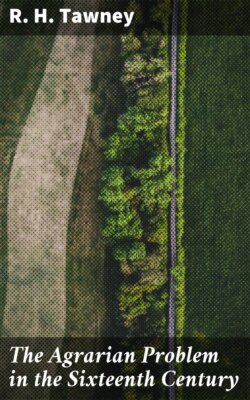Читать книгу The Agrarian Problem in the Sixteenth Century - R. H. Tawney - Страница 19
На сайте Литреса книга снята с продажи.
(a) The Variety of ConditionsToC
ОглавлениеTable of Contents
When one turns from what legal historians have said on the origin and development of copyhold tenure to consider the economic position of this class of tenants, one finds oneself in a region of much greater uncertainty. The legal historian may speak of the copyholders as constituting, in spite of minor differences, a fairly well-defined class. The economic historian cannot. He finds, on the contrary, the widest difference between the economic conditions of tenants holding their land by copy of court roll, not only, as would be expected, in different parts of the country, but on the same manor. In the thirteenth century to say that a man is a villein tells us something at least about his economic position, at any rate when the general features of the manor on which he is a villein are known. He will probably have a standard holding of a virgate or half-virgate; he will have rights in the common meadow land and in the common waste; he will do work on the lord’s demesne. In the sixteenth century tenure is no clue to economic status, and to say that a man is a copyhold tenant tells us nothing at all about the extent of his holding or the sort of husbandry which he pursues. The vast majority of copyhold tenants are peasants, men who make a toilsome living from their land with the help of their families and a few hired servants. But in England by our period the line between class and class has ceased to coincide with differences of title; if copyhold tenure is born of a humble stock, yet it has risen so much in the world that the upper classes are not ashamed to hold out a hand to welcome it; and among copyholders are found the names not only of many small freeholders, but also of gentlemen and knights.[119]
Among the peasants who form the bulk of the population there is, again, the greatest diversity. Sometimes the copyholders are simply emancipated villeins, who have commuted most of their services, and who hold by copy instead of at the will of the lord, but whose economic condition has hardly changed at all. Thus in Northumberland[120] the holdings of the copyholders on several manors reflect very accurately the distribution of land between the bondage tenants in the thirteenth and fourteenth centuries; the holdings have grown slightly in size, but they have apparently a more or less continuous individual existence from the earliest times. In parts of Wiltshire,[121] on the other hand, though not in all parts, there is no possibility of establishing any connection between the virgate and semi-virgate of the fourteenth century villeins and the acreage held by the copyholders two hundred and fifty years later; both in size and number the holdings are markedly different. In Norfolk and Suffolk ancient class divisions have often been obliterated altogether, and bond and free lands are interlaced in the holdings of the customary tenants in quite inextricable confusion.
Again, there is the greatest variety in the methods of agriculture.[122] Everywhere among the copyhold tenancies arable land predominates to an extent which is in marked contrast to the frequent preponderance of pasture land on many of the demesne farms. But to some tillage seems to be their sole livelihood, while others are very considerable sheep-farmers. Some are cultivators on quite a big scale, well outside the Board of Agriculture’s interpretation of a “small-holder” to-day, with 80, 90, 100, or even 200 acres of land. Often they are better off economically than many freeholders, and when Harrison and Sir Thomas Smith classify[123] copyholders in general with “day labourers and poor husbandmen,” they must surely have been either speaking loosely, or else thinking not of their economic but of their legal position. But others hold only 5, 10, 15, or 20 acres, so that arithmetical averages of the size of their holdings are very little guide to the real distribution of land. Yet it would not be true to say that such inequality is universal, for in the same county one finds some manors on which the holdings seem all to be cut to a regular standard pattern, and others where the variety of size is almost infinite, while in the North striking divergences of area seem to be as much the exception as they are the rule in the South and the East. On some manors, again, the copyhold tenants have enclosed land and hold much in severalty; on others nearly all of it lies in the open fields. Some have extensive rights of common, while on other manors such rights are non-existent, or are too insignificant to be recorded by surveyors.
In fact the impression given by the surveys is that of a condition of things which is very far from being stationary, but in which, on the contrary, much shifting of property and many changes in the methods of cultivation have been going on, and in which the legal position of the peasants is no guide at all to their economic characteristics. The task of finding a manor to serve as a pattern and standard for the rest, which is hard enough in the thirteenth century, is a sheer impossibility in the sixteenth, and the student works with a deep sense of the danger of sacrificing fidelity to simplicity of statement.
